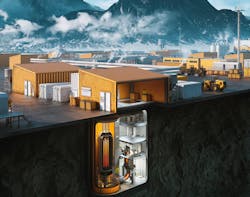NRC Changes Emergency Planning Rules for Future Small Nuclear Reactors
The U.S. Nuclear Regulatory Commission has approved a new emergency preparedness rule for future small modular reactor (SMR) nuclear plants, which some energy industry experts are considering as a potential carbon-free resource for larger-scale microgrids such as data centers and industrial plants.
The NRC has directed its staff to issue a final rule on emergency preparedness for SMRs including non-light-water reactors, research and test reactors and medical radioisotope facilities. The federal Idaho National Laboratory (INL) and others have released reports indicating the small, advanced reactors of the future could help reduce greenhouse gas emissions and ensure resiliency by powering microgrids.
No commercial SMR nuclear plant has yet been built for commercial operation except on a floating vessel in Russia, although the NRC has approved designs by companies such as NuScale Power. The INL hopes to have a test SMR in operation by the end of the decade.
The new rule adopts emergency preparedness plans for a scalable method to determine the size of an offsite emergency planning zone around a nuclear facility. Applicants and licensees for SMRs and other new nuclear technologies would utilize that rule to develop performance-based emergency preparedness programs as an alternative to the current offsite radiological emergency planning requirements, the NRC said.
The NRC ruling is clearly aimed at smaller modular reactor technology.
“This rule excludes: large light-water reactors (those licensed to produce greater than 1,000 megawatts thermal power); fuel cycle facilities; and currently operating research and test reactors. These classes of facilities remain under the current requirements,” the NRC release reads.
Small modular reactor technology, if and when ever physically deployed on a commercial scale, would be made up of a collection of smaller fission reactors which are less than 300 MW in capacity down to about 30 MW. Current, utility-scale nuclear power plants range more in the 1 GW (or 1,000 MW) category.
These SMRs are touted by proponents as potentially ideal for carbon-free microgrids in comparison to conventional fossil-fired power generation and diesel or gas-fired generators, plus more reliable and higher efficiency than solar, wind or battery storage. A data center, for instance, might need 20 MW to 100 MW or more in dedicated energy capacity and cannot be knocked offline without serious negative impact to the economy and information sharing activities.
“The microgrid developed with (natural gas generators), although able to ride through extended electrical grid outages, still requires a continuous supply of natural gas,” reads an Idaho National Lab report done in tandem with software technology firm Xendee last year. “In extended extreme weather or cyber-related outages, the natural gas pipeline/supply chain can get disrupted. On the other hand, small reactors can sustain such extreme outages due to long-lasting fuel. The fuel, once loaded, can last for multiple years…without needing refueling.”
Detractors, whoever, point out the potential safety and health dangers of radioactive material. In a Microgrid Knowledge story earlier this week, one source pointed out the challenge of dealing with amounts of spent nuclear fuel as waste, although the U.S. Department of Energy and other entities have argued that the actual volume of spent fuel covers a relatively small area.
The Union of Concerned Scientists, which supports decarbonization of the power supply and has been cautiously supportive of nuclear energy in general, is more critical of newer generation reactor designs. It also opposes the NRC’s new ruling on emergency preparedness for SMR nuclear.
“Past natural and human-made disasters have taught us that having a robust and workable emergency plan in place is the key to minimizing human suffering and loss of life if the unthinkable happens,” Dr. Edwin Lyman, director of nuclear power safety at the Union of Concerned Scientists, wrote in a statement opposing the new NRC ruling.
“The NRC’s reckless decision today flies in the fact of that experience,” Lyman added. “Concerns with the rule expressed by the Federal Emergency Management Agency and other authorities demonstrate how out of step the NRC is with experts on this issue. Coupled with other trouble regulatory changes that the NRC has already made or is considering, this new rule will only increase the dangers for the public from the next generation of nuclear plants.”
Earlier this year, the NRC certified NuScale Power’s SMR design. In the Federal Register, the NRC noted the safety compliance elements of the small nuclear reactor concept.
From EnergyTech: NRC Approval moves NuScale SMR Design Closer to On-Site Reality
More on Nuclear Energy in Microgrid Knowledge
“NuScale incorporates several innovative features that reduce the overall complexity of the design and lower the number of safety-related systems necessary to mitigate postulated accidents,” reads the report. “NuScale has no safety-related functions that rely on electrical power. For example, the emergency core cooling system performs its safety function without reliance on safety-related electrical power or external sources of coolant inventory makeup.”
In 2020, after several years of review, the NRC concluded that NuScale’s design ensured a safe shutdown and containment in the event of future emergency conditions. The SMR modules, each theoretically capable of producing about 50 MW at capacity, would all be submerged in a pool built below ground level, according to the NRC report.
NuScale is not the only group looking to build small reactors and possibly power large-scale microgrids by the 2030s. Other companies working on the SMR technology include Westinghouse, Holtec, Rolls-Royce, GE-Hitachi Nuclear, and startups such as Global First Power, X-energy and TerraPower.
Nuclear power does not emit carbon dioxide in combustion and currently delivers about 20 percentof the electricity mix in the U.S. and a similar amount worldwide. It also provides more than half of the carbon-free utility-scale electricity generated in the U.S.Opponents, however, point out the safety and environmental threats of radioactive material with long half-lives near populations. They also note the meltdown disasters such as Fukushima in Japan and Chernobyl in Ukraine, which caused the worst nuclear energy meltdown in history.
The story earlier this week in Microgrid Knowledge focused on the increasing interest in SMR nuclear and its potential role in microgrid development. The only operating small reactor is the Akademik Lomonosov floating unit in Russia.
However, many microgrid developers are not sold on the idea of nuclear due to cost, waste, and the fact that microgrid power generation must be located close to the load.
“Who’s going to want a nuclear reactor where they live?” Mike Byrnes, senior vice president of facilities and building services at Veolia North America,” said in a story posted last year.
Others, such as the U.S. Department of Energy and Argonne National Laboratory, have said there are numerous myths about the dangers of licensed nuclear energy. Argonne National Lab’s page, quoting the American Nuclear Society, said that Americans actually get much higher doses of radiation from coal-fired power, airline travel, and even eating a banana. And, Argonne added, no member of the American public has been injured or killed in the more than five decades of commercial nuclear power operation, the ANL statement read.
Argonne National Lab: 10 Myths about Nuclear Energy
Operational mistakes and oversights in Reactor Unit 4 at Chernobyl in the 1980s, however, resulted in the worst nuclear accident in history. The then Soviet Union was slow to react and to reveal details of the disaster, which killed close to 100 people and perhaps more over time.
Groups from the World Health Organization and United Nations have reported on lingering impacts from the Chernobyl and Fukushima meltdowns.
Stay up to date with the latest microgrid projects. Subscribe to the free Microgrid Knowledge Newsletter.
About the Author
Rod Walton, Microgrid Knowledge Managing Editor
Managing Editor
For Microgrid Knowledge editorial inquiries, please contact Managing Editor Rod Walton at [email protected].
I’ve spent the last 15 years covering the energy industry as a newspaper and trade journalist. I was an energy writer and business editor at the Tulsa World before moving to business-to-business media at PennWell Publishing, which later became Clarion Events, where I covered the electric power industry. I joined Endeavor Business Media in November 2021 to help launch EnergyTech, one of the company’s newest media brands. I joined Microgrid Knowledge in July 2023.
I earned my Bachelors degree in journalism from the University of Oklahoma. My career stops include the Moore American, Bartlesville Examiner-Enterprise, Wagoner Tribune and Tulsa World, all in Oklahoma . I have been married to Laura for the past 33-plus years and we have four children and one adorable granddaughter. We want the energy transition to make their lives better in the future.
Microgrid Knowledge and EnergyTech are focused on the mission critical and large-scale energy users and their sustainability and resiliency goals. These include the commercial and industrial sectors, as well as the military, universities, data centers and microgrids. The C&I sectors together account for close to 30 percent of greenhouse gas emissions in the U.S.
Many large-scale energy users such as Fortune 500 companies, and mission-critical users such as military bases, universities, healthcare facilities, public safety and data centers, shifting their energy priorities to reach net-zero carbon goals within the coming decades. These include plans for renewable energy power purchase agreements, but also on-site resiliency projects such as microgrids, combined heat and power, rooftop solar, energy storage, digitalization and building efficiency upgrades.

